Kia EV6 not charging 12 V battery from drive battery / Kia EV6 hleður ekki 12 volt rafgeymi -- íslensk þjónustulund hjá Öskju
While a car with a combustion engine charges its 12 V battery via an alternator, electric vehicles (EVs) have a DC-DC converter to step down the 400 V or 800 V from the drive battery to charge the 12 V battery. This is done when the car is switched on (because then, a lot of electronic control units (ECUs) drain the 12 V battery), but also when the car is switched off while charging the drive battery (while only a few ECUs need to be active to control the charging, charging the drive battery can take many hours which could drain the 12 V battery even with the few active ECUs). Typically, even when the EV is completely switched off (which includes that the drive battery is disconnected for safety reasons), it wakes up occasionally and checks the voltage of the 12 V battery and charges it if necessary (by connecting the drive battery for the DC-DC converter). Problems can occur if the car is switched off, but you still do something that prevents the ECUs from sleeping, e.g. have the trunk door open for loading/unloading the car. So try to keep this short, otherwise the 12 V battery is dead after a few hours.
Also, when the drive battery is reaching a low (20% for the Kia EV6, 10% after the 2023 ICCU firmware update, at least for the ICCU in the US, not sure whether this applies globally) state of charge (SOC), the 12 V may not get charged anymore (to protect the expensive drive battery from getting deep-discharged -- it is cheaper to replace a 12 V battery than a drive battery. Anecdote: the early Tesla Roadsters had no 12 V battery but were constantly draining the drive battery by having the DC-DC converter on all the time, thus depleting the drive battery. Finally, Tesla added the 12 V battery.). So avoid, e.g., driving to the airport leaving only minimal juice in the drive battery, because if you park then the car while you are in vacation, the car will not charge the 12 V battery.
How can you find out when the DC-DC charging is going on: you may be tempted to use a voltmeter (you will measure 14 V during DC-DC charging), but some cars (this seems to be the case for Kia EV6) do not charge the 12 V battery while the bonnet is open (to avoid any interference of the 14 V DC-DC voltage with what you are doing, e.g. trickle charging the 12 V battery). Important: even for a simple thing such as exchanging a 12 V battery, you might want to disable the high-voltage drive battery. In the Kia EV6, this is very easy: in the fuse box below the bonnet, there is a fuse-like cut-off switch that you can easily pull.
To show that the drive battery is activated even though the car is off, some cars have a light (e.g. the Hyundai Kona or even the US version of the EV6), but the European EV6 seems not to have such an indicator (while there is a bulb in the middle of the dashboard where the US versions are reported to have a light, this seems to be unused in the European versions). For the IONIQ5, it is claimed that open front vents indicate DC-DC charging and I have the feeling that this is also the case as well for my EV6 (when charging a lead-acid battery, hydrogen can emerge and opening the front vents may help to dilute the hydrogen to reduce the danger of explosions).
But there are also defects that can drain the battery, e.g., for the Hyundai IONIQ 5, it is well documented that the charge door module has often defects that prevent some ECUs to go to sleep (or the charge door ECU itself is defect). As a result, you find many reports of people who encounter a dead car in the morning.
EV6
But the case here is different: the car is alive, but still does not charge the 12 V battery: while the 12 V battery voltage is low, it has not yet been fully drained, i.e. it is possible to start the car: the car should then notice that it has to charge the 12 V battery, but due to some defect, it does not do so.
Update: A year later, I know now that the Integrated Charging Control Unit (ICCU) and a related fuse were damaged. In some cases, only parts of the ICCU are damaged and it is not possible to charge the car via AC, but DC fast charging is still possible and the DC-DC 12 V charging still works as well. In my case, in addition some fuse was blown which leads then to the 12 V battery not being charged and drive-train issues. I has to be noted that the car was brand new, so no real wear can have occurred, yet. In my case, it seems that there was a coolant leakage inside the ICCU thus submerging the electronics in coolant resulting in high currents that make the fuse (that is external to the ICCU) blow.
This is from a brand new Kia EV6 (84 km driven, bought 3 days ago) that has a problem that manifests among others with a 12 V battery that is not charged by the drive battery via the DC-DC converter (and also warnings concerning the drive electrics and switching to turtle mode -- it is hard to say whether these warnings are a symptom of the 12 V battery low voltage or whether that fact that it does not DC-DC charge the 12 V battery voltage is a symptom of a more severe failure to which the drive electrics warning and turtle mode refer to). After switching the car on, everything was normal except a message popping up: "Check electric vehicle system", followed later by a "Stop vehicle and check power supply" (complaining about a low 12 V battery) and "Power limited" (turtle mode). But as the car is switched on (into ready mode), it should charge the 12 V battery using the DC-DC converter. I tried also AC charging the drive battery (which should also lead to charging the 12 V battery), but after one minute, the AC charging of the drive battery gets aborted by the car. I then switched the car off, hoping that it sooner or later periodically checks the 12 V battery and charges it -- but this did neither work (instead, the battery is dead now: following 7.5 V, it is now down to 3 to 4 V which means the 12 V battery is now deep-discharged, i.e. damaged and needs to be replaced -- but this of course only makes sense after the root cause of the problem has been fixed, e.g. a broken DC-DC converter or a broken ECU or simply some missing update of a buggy firmware -- but the car dealer promised me that all firmware updates have been applied when I pointed out that I am paying the model year 23 price for a model year 22 car that is shipped with ECUs firmwares that are not as new as the model year 23 firmwares).
I have documented this in a video where you see first how the AC charging gets aborted after one minute (no charging limit was active and the SOC was 67%, i.e. it should have charged up to 100%): Drive battery AC charging aborted after one minute (0:00-1:32). Click to play video.
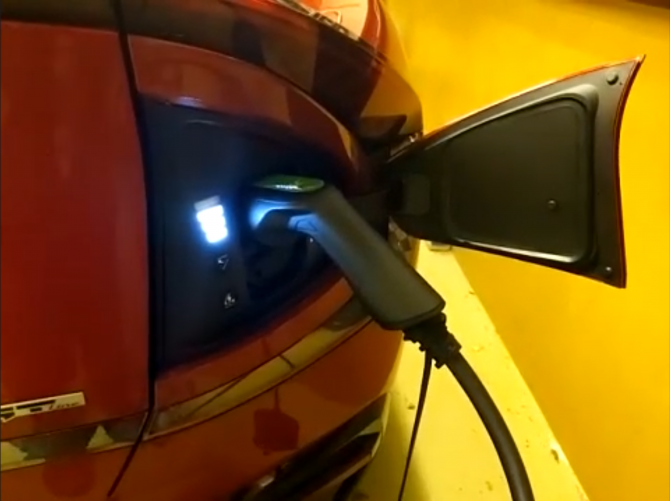
In the remainder of the video, you can see how the car is switched on, but still, the 12 V battery gets not charged: Car turned on with 12 V battery warning, but not charging 12 V battery (1:42-4:37). Click to play video.
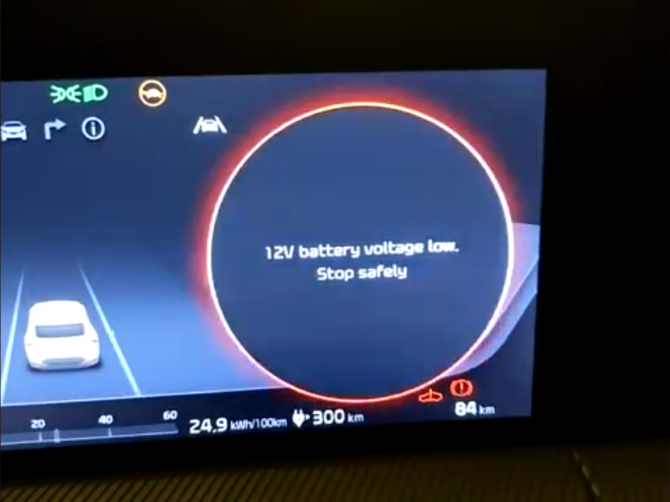
Update: as the 12 V battery gets not charged, the voltage is now down to 3.1 V and the car is completely dead: 12 V battery voltage down to 3.1 V (0:00-0:23). Click to play video.
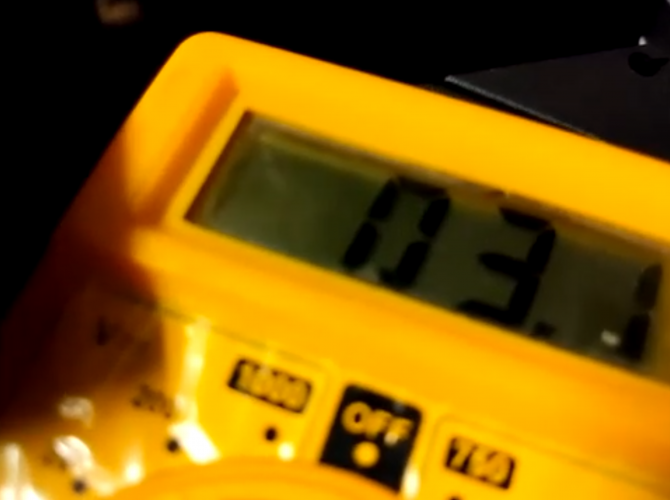
Another explanation for any erratic behaviour could be a special fuse that is used when shipping cars: it is pulled to make the car drain the 12 V battery as little as possible during transport. If it is then not properly pushed in by the receiving dealership, the car can behave very strange. But in fact, the EV6 did behave normal during the first two days, so this is not very likely (and I do not know whether the EV6 has such a fuse at all).
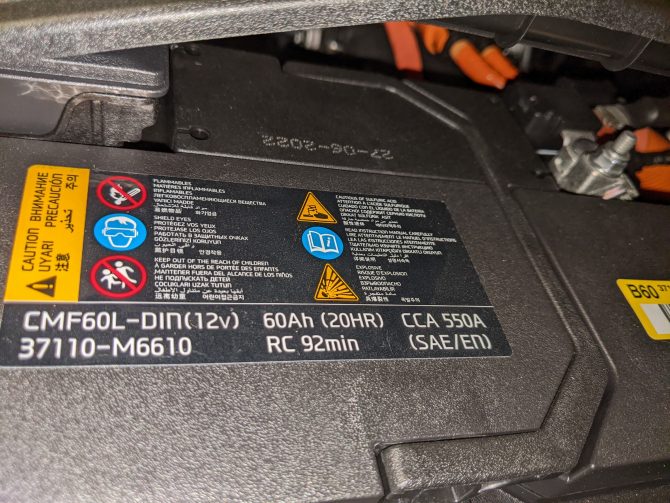
12 V battery: produced 27-06-2022, killed 3-12-2022 by a faulty KIA EV6.
Bílaumboðið Askja -- four days to come with a tow truck
3-12-2022 and 4-12-2022:
As it was a weekend, I wrote on 3-12-2022 my car dealer at the dealership Bílaumboðið Askja (official Kia importer in Iceland) an email about the problem. Also, I used on 4-12-2022 the web form that Bílaumboðið Askja suggests to use outside opening hours in those cases where the road-side service cannot help (the road-side service would come with a battery jump start booster pack, but it is clear that jump starting alone would not help) and I asked Askja to call back.
Let's hope, the Kia service can find the root cause of the problem (but: when they mounted winter wheels, they filled the tyres with a too low pressure: 29 PSI; also for these rims, the document of approval states that the vehicle owner needs to be notified to check after 50 km the torque of the wheel studs/bolts of the winter rims, which they did not do -- maybe they are not got at these basics, but very good in EV diagnostics).
Update 5-12-2022: I was too optimistic with the Kia service at Askja -- I should have written :"Let's hope that the Kia service reacts." My first contact was 3-12-2022 with the salesperson of Askja (as the seller is the one who is in charge (pun intended) of warranty and in fact the warranty conditions recommend to contact the seller). That salesperson at least answered 5-12-2022 and claimed that their service will contact me. (As written above, I had in fact already contacted Kia service in the way they recommend on their web page, namely via a web form, on 4-12-2022 and asked them to call back -- but as of 5-12-2022, Askja service did not even call back.) When I pointed out to that salesperson that the service did in fact not contact me, that salesperson simply stopped answering my emails. (From that point I assumed that any electronic communication with the Kia staff is hopeless.)
Update 6-12-2022: Still no answer from KIA service. So, I finally drove to the KIA dealership (luckily, I have a Mitsubishi Outlander PHEV -- a very reliable car that never let me down -- and its 5 year old 360 degree camera is in fact better stitching the camera images together than the EV6 360 degree camera). I saw then there the salesperson who does not answer my emails sitting bored at his desk, so I considered it pointless to talk to that person and went instead to the service desk. When I pointed out, that they do not answer my service request, they claimed, I used the wrong web form (well, it was the one that they recommend to use on their web page, i.e. they do not know their own web page). But at least, they promised to fetch the car tomorrow (why not today?). I also handed them over a signed letter requesting free warranty service with a deadline to fix the problem within two weeks (I did send that one already as email to the salesperson from whom I bought the car, but he did not confirm having received it), maybe that helps. Ironically, I found in my email spam folder today an email where I was asked to evaluate the service of that salesperson. Update of update: Finally, they phoned me (after I have driven to Askja) and they excused for calling so late because there was a meeting in the morning -- but this does not explain why they did not call me already, e.g., the day before.
Update 7-12-2022: The tow truck now actually came (4 days after I reported the problem) after I have told on the phone that the 12 V battery is dead. But, well: to start a vehicle with a dead 12 V battery, you need a jump starter booster pack and guess what: the booster pack in the tow truck was not charged. As the DC-DC converter does not charge the 12 V battery, the booster pack needs to be permanently be connected to the dead EV6 12 V battery and while we were trying to drive the car on the ramp, the EV6 switched off as the booster pack did not have enough juice anymore. Also, as the EV6 is in turtle mode ("limited power"), the EV6 cannot even climb the tiny ramp of the tow truck, so it has to be winched up. But first, a new (=fully charged) booster pack is needed that the tow truck is fetching right now (at least: solution-oriented and some progress is made).
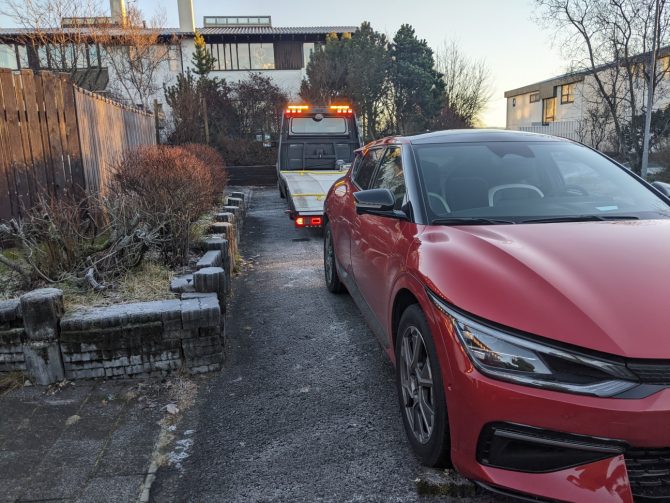
No juice in the jump start booster pack, no EV6 that can be put into "Neutral" to winch it up the tow truck -- tow truck drives home again to fetch a booster pack with juice
Once the tow truck came back with a charged booster pack and putting the EV6 gear setting into "Neutral", it was possible to winch up the car. Once the car had 12 V again, the DC-DC charging did still not work (despite the bonnet being closed), i.e. the reset due to the dead 12 V battery did not solve the issue (either there is some error set in the memory that needs to be cleared first or there is really a serious problem).
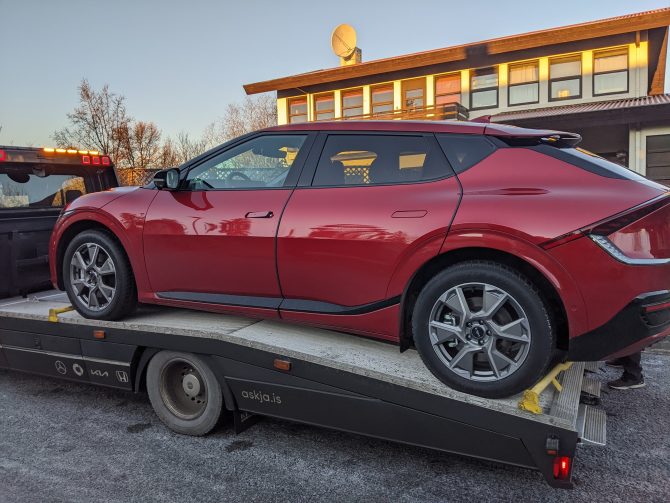
EV6 winched up on the tow truck -- 4 days after reporting
Let's hope the service finds the problem (and of course replaces the dead 12 V battery). Good news (finally): At least, the service seems to be working on the car: the car was fetched 14:15, and at 16:39, I received the first signs of life via the Kia Connect app.
Update 9-12-2022: After two days of repair (compare that to the four days of waiting for the tow truck), I got a call that some ECU needs to be replaced (a fuse inside that ECU has blown), but they could not tell me which ECU (maybe the Integrated Charging Control Unit (ICCU)). While they do not have it on stock, they took it from one of their EV6 that they have standing around (instead of needing to wait weeks for a replacement to be shipped) -- so that is finally good service. I have now fetched my car: it works, but they did not replace the 12 V battery, even though it can be expected that it is now damaged after having been deep discharged to 3 V -- that is bad service. (I hope when I leave the car a couple of days at, e.g., the airport, the battery is still OK once I return.)
I also had now time to check the versions of the head-unit firmware: this are old, very old (navigation app from 26-01-2022 and firmware from 07-04-2022) -- despite the Askja salesperson promising that all updates have been made. (When I bought the car, I did not know where to look up the firmware versions -- but the salesperson has to know the cars he sells, so he could have looked that up.) But as the head unit firmware can be updated by the owner, it seems to be Kia policy to update only those firmwares that only the dealer can update.
(At least, I was able to update the navigation/infotainment system firmware on my own.) At least, the firmware fix for the Kia recall SC236 for the parking brake was already applied (according to CarScanner OBD, my ECU GSM-GearShiftCtrl has the Calibration ID: ECV1XXXXXAE19XS2 -- which means the fix has been applied).
(While there is the Kia page https://eu-account.kia.com/auth/realms/eukiaidm/account/ for the Kia Connect account needed for the app, it does not list recalls. I tried also creating an account at https://www.mykia.de which knows my VIN (with a wrong warranty start, though), but assumes a German address and German dealer, so I aborted that.)
Update 15-12-2022: I was wondering what happened to my reservation deposit that I paid one year ago: Askja did not offset the reservation deposit against the buying price when I actually bought the car. Based on the above experience that Askja does not react to questions, I gave up trying to get an answer from them when and therefore rather asked in an Icelandic Facebook group other EV6 owners whether they got the deposit offset and guess what: Askja answered in the Facebook group within an hour. Also when I sent via email a complaint about the bad service to Askja, I got an answer that they want to look into this issue within a few hours. It seems that any way is better to contact Askja than the one that they recommend on their web page where they describe how to contact them in case of urgent problems. It seems, Askja really has a quality management problem.
Update 21-12-2022: I cheered to soon: concerning my 15-12-2022 email complaint about the bad service to Askja where I got within a few hours an answer that they want to look into this issue: I got on 16-12-2022 a short e-mail that they did not have time to look into the issue, but intend to do so. Since then, I did not hear anything from them.
Service mentality in Iceland
This terrible service mentality in Iceland (first, you try to contact via email: no answer, then you try to phone: they do not lift up the receiver, only after driving there and talking directly to them helps: they typically ask you then to write them an email with all the details, i.e. you go back to the first step) is due to a lack of competition: the country is so small that there are no competitors.
This terrible service mentality is also discussed in Icelandic car owners forums, and there it was claimed that this is in particular a problem with car dealers/service in the capital area and that I should next time go to some dealer and service on the country side. I regret therefore already that Bílaumboðið Askja got my money for the car. In fact, I did so far import all my cars on my own, and this was the first time that I used an Icelandic dealership -- which was obviously a mistake. But I should have known better: when I was considering buying my Mitsubishi Outlander PHEV in Iceland (to avoid the hassle of self-import), the salesperson of the Icelandic dealership Hekla was so incompetent (i.e., I knew more about the car than he), that I thought: no, they will not get my money -- I did then rather import it on my own from a competent dealer in Germany that gave me even a better price.
For sure, this was the first and the last car that I bought from Askja and I will try to avoid their service and in future rather combine the scheduled warranty inspections with a trip the countryside. One would think that a good salesperson is aware that happy customers come back and buy the next car as well with them (and potentially an even more expensive car) -- but this service thinking does simply not exist in Iceland.
Apropos thinking: there is also no understanding concerning the revolution of Vehicle-to-load (V2L) and future Vehicle-to-Grid (V2G): while in future, V2G will help to deal with peak usage, V2L allows me already now to have electricity during camping, power my fridge when there is a power outage or use a hair dryer even the charging cable is frozen in the charge port. The importer Askja ordered the cars from Kia in Korea without a 230 V socket inside the cabin (I asked the salesmen about this and they said they consider it unnecessary -- but in winter, you would need that socket exactly to power a hair dryer in case if your charge port is frozen). Also, the GT line that comes elsewhere with the V2L adapter included, does not come with such an adapter when you buy it from Askja (and of course, I will not buy that adapter from them: you can get them for half of the price elswhere).
Update 1-3-2025:
Askja still does not answer questions: when I gave them my car for the Q1/2025 ICCU/VCU update (see below), I sent them an email because the 12 V battery was failing exactly after the European 2 years warranty of the 12 V battery had passed. I pointed out that in my opinion the ICCU failure had damaged the battery and which lead to the 12 V battery failing now. But they ignore my email and do not reply.
ICCU firmware updates to prevent future ICCU defects
Update 8-11-2023: My EV6 now got Service campaign SC271 applied, i.e. a firmware update of the ICCU that hopefully prevents this from happening again. Based on CarScanner OBD ECU readings, the version numbers ("Manufacturer ECU software number") for the ICCU changed as follows):
Before SC271:
4WD #1 / OnBoard Charger (Hybrid/EV)
SW Boot ver.: NEICCU51
SW ver.: NE1A024
ECU serial number: 123456789ABCDEF
ECU part. num.: 364011XFB0
Idents string: NE1A024
Manufacturer spare part number: 364011XFB0
Manufacturer ECU software number: ECV1E1-IES05R000
ECU manufacturing date (ASCII): !
System supplier ECU hardware version: 364011XFB0
ECU manufacturing date (HEX): 20210906
Programming date (HEX): 33363430313158464230
After SC271:
4WD #1 / OnBoard Charger (Hybrid/EV)
SW Boot ver.: NEICCU51
SW ver.: NE1A037
ECU serial number: 123456789ABCDEF
ECU part. num.: 364011XFB0
Idents string: NE1A037
Manufacturer spare part number: 364011XFB0
Manufacturer ECU software number: ECV1E3-IES12R000
ECU manufacturing date (ASCII): !
System supplier ECU hardware version: 364011XFB0
ECU manufacturing date (HEX): 20210906
Programming date (HEX): 33363430313158464230
However, that software update seems to have mainly been about warning earlier about the ICCU failure after it occurred (so that you have more time to leave a busy road and drive your car to a safe spot), but not preventing it. The video below shows a paper that says in the first 10-22 minutes of ICCU failure detection, full motor power will be available and only after 21-45 minutes, some fail-safe mode (vehicle stops).
Update 21-05-2024: My EV6 now got a further ICCU firmware update (namely SC302) that aims at actually preventing ICCU failure: avoiding spikes at the end of charging (there have indeed been many reports about RCDs tripping at the end of charging due to these spikes), better cooling, also the 12 V battery charging pattern might have changed.
4WD #1 / OnBoard Charger (Hybrid/EV)
SW Boot ver.: NEICCU51
SW ver.: NE1A038
ECU serial number: 123456789ABCDEF
ECU part. num.: 364011XFB0
Idents string: NE1A038
Manufacturer spare part number: 364011XFB0
Manufacturer ECU software number: ECV1E3-IES13R000
ECU manufacturing date (ASCII): !
System supplier ECU hardware version: 364011XFB0
ECU manufacturing date (HEX): 20210906
Programming date (HEX): 33363430313158464230
Update 28-03-2025: My car will get today another update that includes a VCU update. Not sure what recall ID this is, but for Q1/2025, I found in discussion forums an update "Limp mode" -- which is essentially the mode that is used when a failure is detected, e.g. restricted speed. I found SERVICE ACTION: LIMP-HOME MODE OPERATION LOGIC IMPROVEMENT (SA5599) (which is of type "ELE", meaning that is an "elective" recall) -- however my VCU part number is 397511XCE1 which is not listed in that document. In addition, I found for the IONIQ 5 (which has the same eGMP VCU and ICCU) 40D240 Programmier VCU Ioniq 6-5 (CE-N) and 40D236 ICCU reprogrammiert und/oder ICCU und Sicherung von Ioniq 5 und Ioniq 6 (NE-CE) applied in 2/2025 which would fit the fact that I will get a VCU update and a second not further specified update. That ICCU update seems to try to limit again peak currents in the DC-DC conversion (softstart LCDC, i.e. ramping slowly up the current when the DC-DC conversion starts) and the VCU update might lower the SOC limit of the drive battery for DC-DC charging from 20% to 10% (however, I thought that this change was included already in earlier updates), but it might also improve reliability of the remote conditioning. But these VCU improvements would not fit to the above Limp mode technical service bulletin. Reports say that ICCUs have been failing even after that update. Some electronics expert dissected a damaged ICCU, did some SPICE simulations) (in German) and is seems that this can anyway not be fixed by firmware updates, but really a new ICCU hardware would be needed.
The update changed the following (left=before, right=after update):
ICCE firmware version has increased from NE1A038 to NE1A039 and SW number from ECV1E3-IES13R000 to ECV1E3-IES14R000:
4WD #1 / OnBoard Charger (Hybrid/EV) 4WD #1 / OnBoard Charger (Hybrid/EV)
SW Boot ver.: NEICCU51 SW Boot ver.: NEICCU51
SW ver.: NE1A038 | SW ver.: NE1A039
ECU serial number: 123456789ABCDEF ECU serial number: 123456789ABCDEF
ECU part. num.: 364011XFB0 ECU part. num.: 364011XFB0
Idents string: NE1A038 | Idents string: NE1A039
Manufacturer spare part number: 364011XFB0 Manufacturer spare part number: 364011XFB0
Manufacturer ECU software number: ECV1E3-IES13R000 | Manufacturer ECU software number: ECV1E3-IES14R000
ECU manufacturing date (ASCII): ! ECU manufacturing date (ASCII): !
System supplier ECU hardware version: 364011XFB0 System supplier ECU hardware version: 364011XFB0
ECU manufacturing date (HEX): 20210906 ECU manufacturing date (HEX): 20210906
Programming date (HEX): 33363430313158464230 Programming date (HEX): 33363430313158464230
VCU calibration number changed from 019ED8F8D0 to 0197B5F8FA:
ECU name: VCU -VehicleControl ECU name: VCU -VehicleControl
Calibration Verification Numbers: 019ED8F8D0 | Calibration Verification Numbers: 0197B5F8FA
Gear shifter Control (which also includes the "P" mode, e.g. I had an earlier update on engaging the parking break) SW version changed from CV1A-E0-SB4-V400 to CV1A-E0-SB8-V400 and SW data id from CVE21228 to CVE40611:
ECU name: GSM-GearShiftCtrl ECU name: GSM-GearShiftCtrl
Calibration Verification Numbers: 01BC4450BC Calibration Verification Numbers: 01BC4450BC
Calibration ID: ECV1XXXXXAE19XS2 Calibration ID: ECV1XXXXXAE19XS2
Vehicle Motor control unit Vehicle Motor control unit
SW ver.: CV1A-E0-SB4-V400 | SW ver.: CV1A-E0-SB8-V400
SW data id.: CVE21228 | SW data id.: CVE40611
Update 22-04-2025: New AGM 12 V battery Finally, my OEM 12 V battery died. Luckily, I had a powerbank-style jump starter (Buture BR300 that however revived the EV6 only if it is fully charged). I replaced the 12 V battery by a Varta AGM Silver Dynamic AGM (on forums, people claim that AGM fits better the charging pattern that the ICCU uses for charging the 12 V battery and the facelift IONIQ5/EV6 models come now with OEM AGMs as well). For the record, the Varta short code is D52. The size is: 242x175x190, i.e. DIN H5 / EN55 L2 / Group 47, bottom hold down type: B13. Also, take care to have the correct the terminal polarity orientation scheme, i.e. type 0. While the shop, I ordered the battery from, listed the battery as "L2R" which would be type 1, the Varta Silver Dynamic AGM comes only in type 0, so that must have been a typo). Of course, the OEM battery died just as few months after Kia's 2 year warranty on the 12 V battery had expired. As I wrote already further above, I am convinced that the ICCU failure that did lead to deep discharge of the 12 V battery, did in fact kill it and Kia should have replaced that battery together with the ICCU -- but they refused.
Replacing the battery is explained here:
While I did not need to remove the frunk as in the above video, some wiggling was still needed because both the OEM and the aftermarket battery where slightly larger than the frunk opening. While I did also disconnect the high-voltage battery using the yellow piece in the fuse box, I am not sure whether it is really needed: as soon as you open the bonnet, the 12 V battery does not get charged anymore. In addition, there are also instructions floating on forums that after battery replacement, the car needs be turned on, then turned off, locked, left undisturbed for 4 hours. I guess the idea is that the car checks the 12 V battery every 4 hours and by this would learn that it has now a new battery. Not sure, whether this is needed, but it does not harm. If you have a torque wrench: the appropriate torque for the battery terminal is ca. 4 Nm and for the fastening clamp, it is ca. 15 Nm. In my experience, this is anyway the torque that I used intuitively with a normal ratchet. Battery terminal grease was in the past applied as coating after(!) everything has been connected to prevent that acidic gases that evaporate from the battery lead to corrosion. But modern batteries are sealed, so such degassing is minimal (still, I am happy that my Mitsubishi Outlander PHEV that has its 12 V battery inside the cabin has a pipe that leads any gases to the outside of the passenger cabin).
